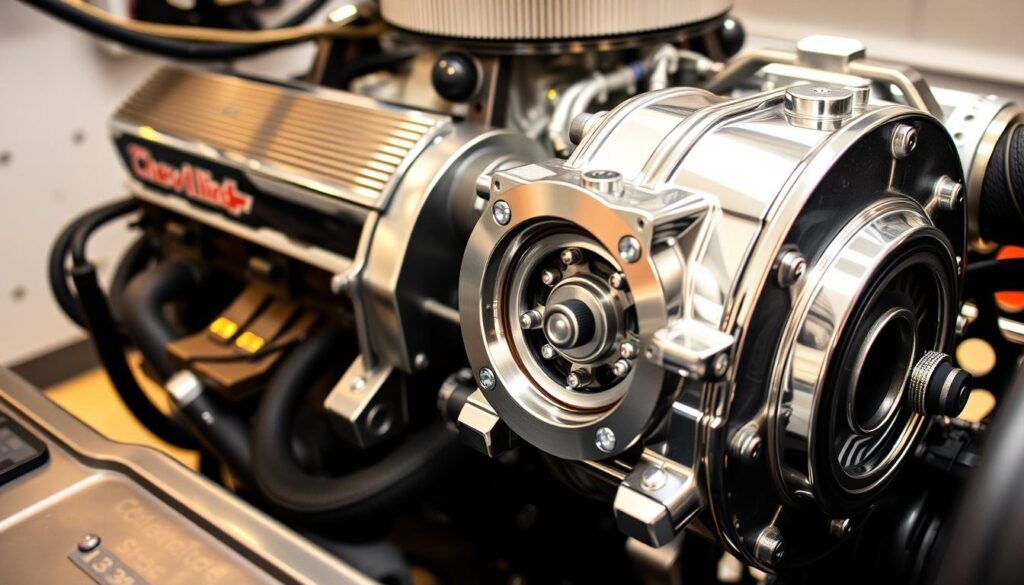Chevy 4 Speed Manual Transmission Guide
Want to learn about the Chevy 4 Speed Manual Transmission? This guide has all you need on this famous Chevy transmission.
Find out its history, designs, and special features. Classic car fans and gearheads love it for good reasons. This transmission has a great history.
It gives drivers top control and power. We’ll look at its different types like Muncie, Saginaw, and Borg-Warner. This way, you’ll know which one is right for you.
Plus, learn about their best uses, from fixing up old cars to boosting their performance. We’ll also cover how to install it, fix common problems, and rebuild it.
Get ready to keep your Chevy in top shape. With this guide, all the helpful tips are right here for you.
Introduction To Chevy 4 Speed Manual Transmission
The Chevy 4 speed manual transmission is an important piece of car history. It gives drivers great performance and control.
Drivers love the excitement of shifting gears themselves, making driving more fun. People who like feeling in charge of their gear changes prefer this over automatic systems.
It’s important to know the benefits of a 4 speed manual transmission. This gearbox improves power use and gives you more control of your car.
Car fans like how responsive it is in different driving situations. Having control over engine revs helps manage power, which makes your car accelerate and handle better.
Choosing a 4 speed manual transmission can also save gas. By using the right gear, you use fuel more efficiently. This type of gearbox makes driving more fun and less expensive.
As you learn more about the chevy manual transmission, you’ll understand why it’s popular with both car enthusiasts and regular drivers.
History of Chevy 4 Speed Manual Transmissions
The Chevy’s journey in manual transmissions began in the early 1960s with the Muncie 4-speed. This lineup became famous for its strong performance in various Chevy cars.
Thanks to the Muncie transmission’s solid build, cars had smoother gear shifts and better control. This revolutionized how cars were driven.
After the Muncie’s success, the Saginaw and Borg-Warner models followed. They introduced new features focused on making driving smoother and more reliable.
Each new version aimed to improve the driving experience. Learning about this progression shows us the engineering leaps made to enhance today’s cars.
It also highlights the longstanding tradition of performance excellence.
Types of Chevy Manual Transmissions
Learning the different types of Chevy manual transmissions can help you choose the right one for your car.
The Muncie, Saginaw, and Borg-Warner 4-speed transmissions are among the top choices. Each type has unique benefits and features for various driving needs.
Muncie 4 Speed Transmissions
The Muncie 4 Speed Transmissions are known for their top performance. They are found in several Chevy models and include the M20, M21, and M22. The M20 is great for everyday driving with its smooth shifting.
The M21 blends performance with durability. The M22, nicknamed the “Rock Crusher,” is all about high power. It’s a favorite among muscle car fans because of its strength.
Saginaw 4 Speed Transmissions
The Saginaw 4 Speed Transmissions are praised for their affordability and solid performance. They’re typically used in economy cars.
This makes them a good pick for those who want to save money but still get a reliable drive. They’re designed for daily driving and are popular with drivers watching their budget.
Borg-Warner 4 Speed Transmissions
The Borg-Warner 4 Speed Transmissions are recognized for their sturdy performance and flexibility. They are used in various Chevy models, including both cars and trucks.
They provide a good mix of durability and ease of use. This makes them a trustworthy option for many different driving situations and uses.
Key Features of Chevy 4 Speed Manual Transmission
The Chevy 4 speed manual transmission is known for its remarkable design and the way it works. It offers performance, durability, and is easy to use.
These features are important in making your driving experience better and helping your vehicle last longer.
Durability and Performance
Chevy’s 4-speed performance is strong because of its tough build. This helps it last longer, even in tough conditions.
It comes from models like Muncie and Saginaw and is great for powerful cars. Most users say their transmissions work well past 300,000 miles.
This shows how the design and build focus on strength and reliability.
Ease of Use and Maintenance
Chevy manual transmissions are easy to care for thanks to their simple design. They are easy to rebuild, whether you’re an expert or like to do it yourself.
They come in different gear ratios, which means they’re good for all kinds of driving. Because parts are easy to find, people prefer these transmissions. They help avoid long waits for repairs.

| Feature | Description |
|---|---|
| Durability | Engineered for high endurance, able to withstand heavy usage and abuse. |
| Torque Transfer | Efficient transfer of engine power to wheels, suitable for performance vehicles. |
| Maintenance | Simple design allows for easy service and common parts availability. |
| Longevity | Many users report over 300,000 miles without major repairs. |
| Versatility | Multiple gear ratios available to meet varied performance requirements. |
Transmission Identification and Specifications
Knowing how to spot a Chevy 4 Speed Manual Transmission is key for car fans. It helps with fixing, swapping, and making sure your vehicle has the right match.
Being familiar with the specs of Chevy transmissions makes choosing the right one easier and keeps your car running well.
Common Chevy 4 Speed Models
Learn to recognize the signs that tell you about different Chevy models. Look for these notable features:
- Muncie: Known for its square case and specific bolt pattern. It’s often seen in old muscle cars.
- Saginaw: Has a smaller case and a simpler bolt pattern. It’s found in many Chevy vehicles.
- Borg-Warner: Stands out with its tough build and various case shapes, fitting a wide range of models.
Transmission I.D. Chart Overview
A transmission identification chart makes finding out what type you have easier. It’s really handy for figuring out what you need for repairs or swaps.
A good chart will show:
| Transmission Type | Identification Marker | Common Applications |
|---|---|---|
| Muncie | Square shape, codes typically start with “P.” | Classic Chevrolets and muscle cars. |
| Saginaw | Rectangular case with a simple bolt pattern. | Wide range of trucks and cars. |
| Borg-Warner | Varied case shapes; unique internal components. | Performance and specialty vehicles. |
Popular Applications of Chevy 4 Speed Manual Transmission
The Chevy 4 Speed Manual Transmission is popular for several reasons. People love it for restoring classic Chevy cars or making them perform better.
It’s flexible, fitting different automotive needs. This makes it a first choice for many car fans.
Classic Car Restorations
In restoring old Chevy cars, this transmission is key. It keeps the car’s original feel and power. Using it raises the car’s value and gives real driving joy.
Performance Upgrades
For better car performance, this transmission is a go-to. It’s great for boosting street rods or off-road vehicles.
With the Chevy 4 Speed, you get more power and control. This means more fun driving.

| Application | Description |
|---|---|
| Classic Car Restorations | Offers authenticity and original performance for vintage Chevy vehicles. |
| Performance Upgrades | Enhances horsepower and torque, improving overall vehicle responsiveness. |
Chevy 4 Speed Manual Transmission Installation Guide
Installing a Chevy manual transmission requires precision and attention to detail. Begin by gathering the necessary tools, like a socket set, wrenches, and a transmission jack.
Make sure your workspace is clean and organized to avoid accidents. Start by disconnecting the battery.
Remove any drivetrain components blocking access to the transmission area. This might include the driveshaft and exhaust parts.
After that, carefully align the new transmission with the bell housing. Make sure it fits securely. During the installation, focus on your alignment.
This is crucial for the input shaft to engage correctly with the engine. You might want to use a transmission alignment tool.
This tool helps in getting the transmission in the right spot. Before securing the transmission, check all connections. This includes wiring and fluid lines.
It’s important to ensure everything fits properly. The following table summarizes key steps in the 4 speed transmission installation process:
| Step | Action | Details |
|---|---|---|
| 1 | Gather Tools | Socket set, wrenches, transmission jack |
| 2 | Disconnect Battery | Safety first to prevent electrical issues |
| 3 | Remove Components | Exhaust and driveshaft may need removal |
| 4 | Align Transmission | Use alignment tools if necessary |
| 5 | Secure Connections | Ensure everything is fitted correctly |
By following these steps, you’ll help ensure a successful Chevy 4 speed manual transmission setup.
Paying close attention at each stage improves your vehicle’s reliability and performance.
Troubleshooting Common Issues with Chevy Manual Transmission
Knowing the possible troubles with your Chevy 4 Speed Manual Transmission is crucial. Early recognition of problems can save you repair costs.
By being aware of the usual issues, you can keep your car running smoothly.
Symptoms of Transmission Problems
- Grinding noises when shifting gears indicate an underlying issue.
- Difficulty in shifting gears can mean several mechanical issues.
- Leaking fluid near the transmission usually means it needs fixing.
- Unusual vibrations while driving could mean misalignment or damage inside.
Common Fixes and Solutions
Implementing efficient troubleshooting steps can solve many transmission problems. Here are actions to take for common issues:
- Keep an eye on transmission fluid levels. Low fluid can cause overheating and damage.
- Check the linkage for misalignments or wear. It might need adjusting.
- Inspect all transmission parts to find other possible issues.
- Replace old parts to keep your transmission working well and avoid more problems.

Rebuilding a Chevy 4 Speed Manual Transmission
If you’re thinking about rebuilding a Chevy 4 Speed, this guide is for you. It shows you how to repair the manual transmission so your car runs well again.
By following these steps, you’ll make sure the job is done right.
Tools and Materials Needed
First, gather all the necessary tools and materials. This will help the rebuilding process go smoothly. Here’s what you’ll need:
- Wrenches (various sizes)
- Pliers
- Screwdrivers (flathead and Phillips)
- Torque wrench
- Transmission rebuild kit (gaskets, seals, bearings, etc.)
- Cleaning supplies (solvents, brushes)
- Safety gear (gloves, goggles)
Step-by-Step Rebuilding Process
Here are the steps to rebuild your chevy manual transmission:
- Disassembly: Start by removing the transmission from your car. Remember to take notes or pictures to help you later.
- Inspection: Carefully check all parts for any wear or damage. Focus closely on the gears and bearings.
- Repair or Replace: Use your rebuild kit to replace any damaged parts. Make sure to use new gaskets and seals to prevent leaks.
- Reassembly: With the help of your notes or photos, put the transmission back together. Tighten all bolts as the manufacturer advises for lasting use.
- Reinstallation: After reassembling, put the transmission back in your car. Make sure everything is connected properly.
Upgrading From a 3 Speed to a 4 Speed Manual Transmission
Switching to a Chevy 4 speed manual transmission can majorly boost how your car feels on the road.
This change provides several perks, making your car perform better and drive smoother. With a 4 speed, you get to use your car’s power and torque more effectively over a wider range.
Another big plus of this upgrade is having more control over your gears. With four gears, matching engine output to your driving needs gets easier, whether you’re on the freeway or in the city.
This can also mean using less fuel, especially when driving fast, as your engine works more efficiently.

Before jumping in, thinking about compatibility and setting it up is crucial. Ensure the transmission you pick matches your car type and engine.
The setup might need some tweaks or new parts, so be ready for that to guarantee a smooth change.
Knowing the upsides of upgrading your manual transmission helps in making a wise choice.
Opting for a 4 speed can significantly lift your car’s performance and make driving much more enjoyable.
Chevy Transmission Fluid Recommendations
Picking the right transmission fluid is key for your Chevy 4 Speed Manual Transmission. Knowing about different fluids helps you make smart choices for maintenance and replacements.
Types of Transmission Fluids
You have two main options:
- Manual Transmission Fluid (Gear Oil): This is made for manual transmissions and is thicker than automatic fluid. It helps gears shift smoothly by providing better lubrication, especially under heavy use. Some kinds also have additives to protect against extreme temperatures.
- Synthetic Manual Transmission Fluid: Synthetic fluids are better than regular oils. They protect against wear, don’t break down in high heat, and flow well in cold weather. This makes shifting smoother and helps the transmission last longer.
Optimal Fluid Change Intervals
Regularly changing the fluid in your Chevy 4 Speed Manual Transmission is important.
You should do it every 30,000 to 60,000 miles. But, this can vary depending on how you drive and your car’s specific needs.
If you tow, carry heavy loads, or drive a lot in stop-and-go traffic, you might need to change the fluid more often. Always check your owner’s manual for the best advice for your car.
Conclusion
We have covered a lot about Chevy 4 Speed Manual Transmissions in this guide. You learned about their history, different types, and key features.
This information is crucial for your car’s care and upgrades. Also, we discussed how to install them and fix common problems.
If you love working on classic cars or want to boost your car’s performance, this guide helps. You now know the important details about Chevy manual transmissions.
This knowledge will improve your driving and help your car last longer. You’re ready to face any transmission issues with confidence.
You understand the specs, which fluids to use, and how to rebuild the transmission. Use what you’ve learned to make your and your car’s performance better.
FAQs
What are the benefits of using a Chevy 4 Speed Manual Transmission?
A Chevy 4 Speed Manual Transmission boosts your car’s performance. It lets you choose gears precisely and makes your car more efficient than automatic ones.
How can I identify my Chevy 4 Speed Manual Transmission model?
Check the case shape and bolt patterns to know your transmission model. Also, use the I.D. charts to see if it’s a Muncie, Saginaw, or Borg-Warner.
What tools are needed for rebuilding a Chevy 4 Speed Manual Transmission?
You’ll need wrenches, pliers, and a socket set. Also, gather the specific parts needed for rebuilding.
Why should I upgrade from a 3 Speed to a Chevy 4 Speed Manual Transmission?
Moving to a 4 Speed improves acceleration and how your car drives. It gives you better control of your car’s power.
What are the common symptoms of transmission problems in a Chevy Manual Transmission?
Signs include grinding noises when shifting or trouble engaging gears. Leaking fluid is also a symptom. Fix these issues fast to prevent more damage.
When should I change the transmission fluid in my Chevy 4 Speed Manual Transmission?
Change the fluid every 30,000 to 60,000 miles. Or follow your owner’s manual. This keeps your transmission working well.
What types of transmission fluid are suitable for Chevy 4 Speed Manual Transmissions?
You can use conventional or synthetic fluids. Synthetic fluids usually offer better protection and improve performance.







